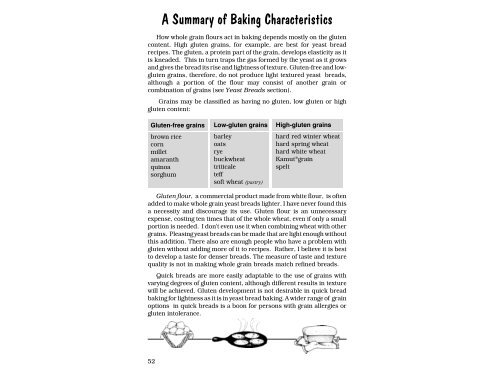Whole Grain Baking - Sue Gregg Cookbooks
Whole Grain Baking - Sue Gregg Cookbooks
Whole Grain Baking - Sue Gregg Cookbooks
Create successful ePaper yourself
Turn your PDF publications into a flip-book with our unique Google optimized e-Paper software.
A Summary of <strong>Baking</strong> Characteristics<br />
How whole grain flours act in baking depends mostly on the gluten<br />
content. High gluten grains, for example, are best for yeast bread<br />
recipes. The gluten, a protein part of the grain, develops elasticity as it<br />
is kneaded. This in turn traps the gas formed by the yeast as it grows<br />
and gives the bread its rise and lightness of texture. Gluten-free and lowgluten<br />
grains, therefore, do not produce light textured yeast breads,<br />
although a portion of the flour may consist of another grain or<br />
combination of grains (see Yeast Breads section).<br />
<strong>Grain</strong>s may be classified as having no gluten, low gluten or high<br />
gluten content:<br />
Gluten-free grains<br />
brown rice<br />
corn<br />
millet<br />
amaranth<br />
quinoa<br />
sorghum<br />
Gluten flour, a commercial product made from white flour, is often<br />
added to make whole grain yeast breads lighter. I have never found this<br />
a necessity and discourage its use. Gluten flour is an unnecessary<br />
expense, costing ten times that of the whole wheat, even if only a small<br />
portion is needed. I don't even use it when combining wheat with other<br />
grains. Pleasing yeast breads can be made that are light enough without<br />
this addition. There also are enough people who have a problem with<br />
gluten without adding more of it to recipes. Rather, I believe it is best<br />
to develop a taste for denser breads. The measure of taste and texture<br />
quality is not in making whole grain breads match refined breads.<br />
Quick breads are more easily adaptable to the use of grains with<br />
varying degrees of gluten content, although different results in texture<br />
will be achieved. Gluten development is not desirable in quick bread<br />
baking for lightness as it is in yeast bread baking. A wider range of grain<br />
options in quick breads is a boon for persons with grain allergies or<br />
gluten intolerance.<br />
52<br />
Low-gluten grains<br />
barley<br />
oats<br />
rye<br />
buckwheat<br />
triticale<br />
teff<br />
soft wheat (pastry)<br />
High-gluten grains<br />
hard red winter wheat<br />
hard spring wheat<br />
hard white wheat<br />
Kamut ® grain<br />
spelt


